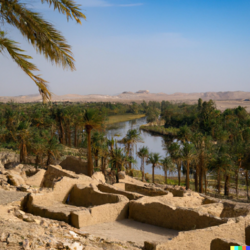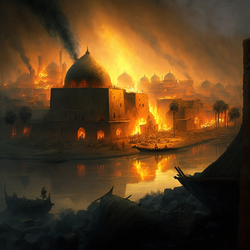Sherwan
| . Cærwan . | |
 Portions of the central citadel | |
| Alternate name | Sharwan |
|---|---|
| Type | Settlement |
| History | |
| Founded | 8th century |
| Site notes | |
| Condition | In ruins |
Sherwan (Koman:Cærwan) located in modern-day Vogia, within in the Golden plains between ? and the ? river. The city was for a larger period of time the capital of the Tamir Khanate and the largest settlement in northern Vaniu until the 13th century.
History
The location around Sherwan was previously used as a trade outpost by the various nomadic peoples inhabiting the Golden plains, this included Kalkalis, Foeian, Rusovian, and other Northern Vaniuan tribes. The area was often frequented by Ohanian merchants, who often traveled around Northern Vaniu following trading nodes. As such, the area was often contested between various tribal confederations and became a point of contention for tribal warlords. The location, however, would fall under full Kalkali control by the 700s as the Qom Confederation consolidated, giving way for the establishment of the Tamir Khanate and its eventual expansion over much of Northern Vaniua.
Capital of the Tamir Khanate
The area around the former city was used as a major trading post until the early 700s, when the Khans of the Qazsara made major efforts to establish a center of administration and command, away from the customary semi-nomadic settlements usually established by Kalkalis and Northern Vaniuan peoples. Efforts in establishing an administrative center gave way to a change in the political structure of the khanate, shifting towards a hereditary monarchy rather than an elective one.
The location of the capital shifted several times until reaching its current placement between insert river name and insert river name, a favored location by the khans as it provided access to trade both inland and major waterways. Initially, the settlement was mainly comprised of adobe and adobe-derived materials, however, a gradual transition towards brick and mortar became increasingly common as the noble class settled in Sherwan. As the Tamir Khanate had converted to Zarasaism shortly after its foundation, Sherwan took on a particularly clerical role in the expansion of Zarasaism in northern Vaniua, with its urban development closely shaped around religious symbolism and Sayanic tenets, this included the construction of more than 300 gharams in its apogee, including the construction of various monuments.
At its height, Sherwan is estimated to have accommodated at least 100,000 inhabitants, reaching around half a million during seasonal migrations, increasing tenfold in size since its foundation. Thanks to its location and easy access, the city was allowed to develop rapidly, becoming the largest settlement in northern Vaniua by the mid-1100s. Its development was aided by the expanse of the khanate and the generally dry climate of the region, making raids and sackings considerably challenging for any enemies.
Destruction
The decline of Sherwan began around 1206 CE with raids from the ever-expanding Sunrise Horde who had been repealed in 1202 CE during the Battle of Hajrem. Due to the resistance led by Kalkalis, attacks from the Sunrise Horde became increasingly devastating and brutal, with surviving accounts describing public flaying, immolation, and massacres becoming commonplace between each raid. Sherwan, however, managed to holdout invaders until 1217 CE, when the Battle of Gheshur allowed the Sunrise Horde to break Kalkali defenses and for the first time, attack the city from a direct point.
During its time of decline, Sherwan's population became severely affected, considered to have been reduced to a mere 40,000 in its final days. As increased raidings from the Sunrise Horde obstructed trade flow in the Golden Plains, much of Sherwan's revenue was reduced into taxing, forcing much of its population to either migrate or regress back into nomadic life.
The increased instability instated by the Sunrise Horde is known for having triggered the southward migration of Kalkalis, specifically those of the former Qom Confederation into modern-day Komania, in an area around southern Melkanchuta. Such migrations drastically changed the demographics of Eastern Vaniu and culminated into the establishment of the short-lived Qomandi Khanate (1218-1289), giving way to the Great Horde by 1289 CE.
Final collapse

